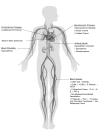Understanding the impact of hypoglycemia on the cardiovascular system
- PMID: 29109754
- PMCID: PMC5669378
- DOI: 10.1080/17446651.2017.1275960
Understanding the impact of hypoglycemia on the cardiovascular system
Abstract
Introduction: Hypoglycemia occurs commonly in insulin requiring individuals with either Type 1 or Type 2 Diabetes.
Areas covered: This article will review recent information on the pro-inflammatory and pro-atherothrombotic effects of hypoglycemia. Additionally, effects of hypoglycemia on arrhythmogenic potential and arterial endothelial dysfunction will be discussed. Effects of hypoglycemia on cardiovascular morbidity and mortality from large clinical studies in Type 1 and Type 2 DM will also be reviewed.
Expert commentary: The relative and absolute risk of severe hypoglycemia leading to death and serious adverse events in both cardiovascular and other organ systems has been highlighted following the publication of recent large clinical trials focused on glucose control and outcomes. It would be helpful if future studies could develop broader end points to include minor and moderate hypoglycemia as well as more robust methods for capturing hypoglycemia contemporaneously with adverse events. In addition, perhaps consideration of including hypoglycemia as a primary outcome, may help identify the possible cause and effect of hypoglycemia on cardiovascular morbidity and mortality.
Keywords: Atherothrombosis; Diabetes; Dysrhythmia; Fibrinolytic Balance; Hypoglycemia; Inflammation.
Conflict of interest statement
Declaration of interest The author has no relevant affiliations or financial involvement with any organization or entity with a financial interest in or financial conflict with the subject matter or materials discussed in the manuscript. This includes employment, consultancies, honoraria, stock ownership or options, expert testimony, grants or patents received or pending, or royalties.
Figures
Similar articles
-
FreeStyle Libre Flash Glucose Self-Monitoring System: A Single-Technology Assessment [Internet].Oslo, Norway: Knowledge Centre for the Health Services at The Norwegian Institute of Public Health (NIPH); 2017 Aug 21. Report from the Norwegian Institute of Public Health No. 2017-07. Oslo, Norway: Knowledge Centre for the Health Services at The Norwegian Institute of Public Health (NIPH); 2017 Aug 21. Report from the Norwegian Institute of Public Health No. 2017-07. PMID: 29553668 Free Books & Documents. Review.
-
Comparative effects of acute hypoglycemia and hyperglycemia on pro-atherothrombotic biomarkers and endothelial function in non-diabetic humans.J Diabetes Complications. 2016 Sep-Oct;30(7):1275-81. doi: 10.1016/j.jdiacomp.2016.06.030. Epub 2016 Jul 4. J Diabetes Complications. 2016. PMID: 27445005 Free PMC article.
-
Hypoglycemia as a driver of cardiovascular risk in diabetes.Curr Atheroscler Rep. 2013 Sep;15(9):351. doi: 10.1007/s11883-013-0351-7. Curr Atheroscler Rep. 2013. PMID: 23881546 Free PMC article. Review.
-
Hypoglycemia and Cardiovascular Risk: Is There a Major Link?Diabetes Care. 2016 Aug;39 Suppl 2:S205-9. doi: 10.2337/dcS15-3014. Diabetes Care. 2016. PMID: 27440834
-
Risk of Major Adverse Cardiovascular Events, Severe Hypoglycemia, and All-Cause Mortality for Widely Used Antihyperglycemic Dual and Triple Therapies for Type 2 Diabetes Management: A Cohort Study of All Danish Users.Diabetes Care. 2020 Jun;43(6):1209-1218. doi: 10.2337/dc19-2535. Epub 2020 Apr 1. Diabetes Care. 2020. PMID: 32238426
Cited by
-
Epidermal growth factor outperforms placebo in the treatment of diabetic foot ulcer: a meta-analysis.F1000Res. 2023 Mar 10;11:773. doi: 10.12688/f1000research.121712.2. eCollection 2022. F1000Res. 2023. PMID: 37867626 Free PMC article.
-
Health-related quality of life in Chinese individuals with type 2 diabetes mellitus: a multicenter cross-sectional study.Health Qual Life Outcomes. 2023 Aug 26;21(1):100. doi: 10.1186/s12955-023-02183-1. Health Qual Life Outcomes. 2023. PMID: 37633882 Free PMC article.
-
Hypoglycemia induces vascular endothelial dysfunction in subjects with normal glucose tolerance.Sci Rep. 2022 Feb 16;12(1):2598. doi: 10.1038/s41598-022-06450-x. Sci Rep. 2022. PMID: 35173220 Free PMC article.
-
Variability in Annual Fasting Glucose and the Risk of Peripheral Artery Disease in Patients with Diabetes Mellitus.Diabetes Metab Syndr Obes. 2021 Sep 24;14:4109-4119. doi: 10.2147/DMSO.S330606. eCollection 2021. Diabetes Metab Syndr Obes. 2021. PMID: 34594122 Free PMC article.
-
A nationwide cohort study for comparative vascular safety of long-acting insulin analogue versus intermediate-acting human insulin in type 2 diabetes.Sci Rep. 2021 Feb 18;11(1):4152. doi: 10.1038/s41598-021-83253-6. Sci Rep. 2021. PMID: 33602950 Free PMC article.
References
-
- Morrish NJ, Wang SL, Stevents LK, et al. Mortality and causes of death in the WHO Multinational Study of Vascular Disease in Diabetes. Diabetes. 2001;2:S14–21. - PubMed
-
- Laakso M. Hyperglycemia and cardiovascular disease in type 2 diabetes. Diabetes. 1999;48(5):937–42. - PubMed
-
- Khunti K, Davies M, Majeed A. Hypoglycemia and risk of cardiovascular disease and all-cause mortality in insulin-treated people with type 1 and type 2 diabetes: a cohort study. Diabetes Care. 2015;38(2):316–22. - PubMed
-
- Cariou B, Fontaine P, Eschwege E. Frequency and predictors of confirmed hypoglycemia in type 1 and insulin-treated type 2 dabetes mellitus patients in a real-life setting: results from the DIALOG study. Diabetes metabolism. 2015;41(2):116–25. - PubMed
Grants and funding
LinkOut - more resources
Full Text Sources
Other Literature Sources


